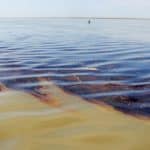Oil spill impacts and solutions
What is an Oil Spill?
- The term Oil spill generally refers to marine spill. This usually happens during transportation of oil in tankers, or when accidentally released from a refinery, storage facility, underwater pipeline or offshore oil-drilling rig. Spills can also occur on land.
How this oil reaches water bodies?
- Between one-third and one-half of the oil in the ocean comes from naturally occurring seeps such as the seafloor springs, where oil leak and rise buoyantly from oil-laden sediments.
- Operation of oil drilling puts some oil into the sea, but this is negligible.
- The large amounts of oil enter the marine environment from tankers and their discharges. Now, we have regulations for minimising such discharges.
- The drippings and emissions from machines and cars or other vehicles we use accumulate on land and eventually run into our waterways.
- Fossil fuel hydrocarbons from engine exhaust also accumulate in the atmosphere. Sometimes the soot is deposited into our waters.
- Even the operation of boats and other ships can contribute to an oil spill.
- Oil spills move due to wave action and also through ocean currents. The waves also break up the oil plumes into smaller portions.
Also Read: What are Algal Blooms?
Impacts of an oil spill
- Oil affects the insulating ability of fur and the water repellency of a bird’s feathers. This can result in their exposure to harsh conditions and subsequently to their death due to hypothermia. It can also make them much less buoyant in water.
- Oil can also prove toxic to certain birds and animals. It affects fish in a different way – oil pollution can stunt the growth of adult fish, enlarge their liver and also damage heart and fins. Oil also adversely affects eggs and larval survival.
- The spill can affect oxygen supply to aquatic species so more species die.
- Animals who rely on scent to find their babies or mothers cannot due to the strong scent of the oil. This causes a baby to be rejected and abandoned, leaving the babies to starve and eventually die.
- Oil can impair a bird’s ability to fly, preventing it from foraging or escaping from predators. It can also blind an animal.
- People should not be allowed on beaches that have been polluted by oil spills as it is very harmful to the skin and also to inhale the benzene found in such fuels.
- Spilt oil can also contaminate drinking water supplies
- Contamination of water bodies can have an economic impact on tourism and marine resource extraction industries.
- It affects the livelihood of fishermen.
Minimising the damage done
- One of the methods to clean the oil spill up includes the employment of long and buoyant booms. These are inflatable tubes that surround and isolate the oil slick. The skimmers suck the oil into containment tanks on the shore.
- Controlled burning can effectively reduce the amount of oil in water if done properly. But it can only be done in low wind and can cause air pollution.
- Dispersing chemicals to break down the oil is another method. Dispersants break the slick into droplets of oil, which is later absorbed into the aquatic system. In the recent incident in Chennai in February 2016, biodegradable oil spill dispersant (OSD) was sprayed
at mid-sea to neutralise the oil slick. - Biodegradation: Some microbes in the sea or ocean water can degrade oil to water soluble compounds and eventually to carbon dioxide. However, some compounds in oil are resistant to degradation. This is largely attributed to the levels of nutrients (nitrogen and phosphorus) in the water. It also depends on the temperature and oxygen level in the water.But to reduce the level of oil, a wide range of microorganisms is required. Biodegradation works best in warm water. Sometimes, nutrients are added to speed up the process.
- When nothing works, the oil is left to disperse naturally. The sun and waves can disperse and evaporate most oils.
An innovative solution to marine oil spills
- Researchers from India have developed a membrane with exceptionally hydrophobic and extremely high oil-loving (oleophilic) properties.It can potentially be used for tackling the globally challenging issue of marine oil spills.
- The ultra hydrophobicity was achieved by synthesising the Metal-Organic Framework with a high density of fluorine; fluorine is inherently hydrophobic in nature and any material that is fluorine-rich becomes hydrophobic. By virtue of being highly hydrophobic, the MOF membrane, by default, becomes distinctly oleophilic or oil-loving in nature.
- When a water-oil mixture is passed through the membrane the oil permeates by rapid absorption, while water is retained above the membrane. So, the membrane acts as a filter.











